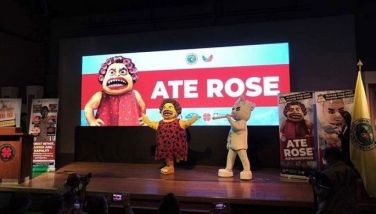Spray anything
Will the notoriously anonymous street artist Banksy, who made the 2010 Oscar-nominated documentary Exit Through the Gift Shop, actually show up for the Feb. 27 awards ceremony in Los Angeles? More likely, if he wins, he will keep his anonymity by sending an envoy, someone to spray paint his thanks on the Oscar stage, perhaps. That might be fitting.
Like a lot of mildly curious people, I didn’t realize until watching Exit Through the Gift Shop that the film focuses not on Banksy, but rather on French would-be filmmaker Thierry Guetta, who happened upon the street art phenomenon in the late ’90s, video camera in hand. Banksy, who directed this intriguing documentary (actually assembled from tens of thousands of hours of video shot by Guetta), appears in the opening shots, his face pixellated and voice altered, to make things clear: this is a film about Guetta, not himself.
But it’s also a film about art, pranks, fame and instant celebrity.
Of course, there exists another distinct possibility: that Exit Through the Gift Shop is an elaborate hoax in a year of “prankumentaries” such as Joaquin Phoenix’s I’m Still Here; that Banksy and other artists merely used the French Guetta as a “front,” supplying their own ideas and imagery to perpetrate an art exhibit with a non-artist to show how gullible the public could be. (This is what our friend and artist Igan D’Bayan insists, but he is prone to conspiracy theories. And rightfully so.) Banksy himself denies it’s all a hoax, but how believable is he? Exit Through the Gift Shop offers us two or three of the most unreliable narrators in documentary history. Either way, it’s one of the most entertaining films of 2010, guaranteed to spur more debate than the ending of Chris Nolan’s Inception.
In the opening, we get a brief but fascinating tour of street art, an offspring of ‘80s graffiti: full of puns and pop culture allusions, its stenciled, mass-produced images provoke baffled reactions from city dwellers, meanwhile extending the fame of its renegade artists. Of course, it’s also illegal, which adds to the fun. (Or, as Banksy wryly puts it, “What I do is kind of in a legal gray area.”)
 French leave: Thierry Guetta, who videotapes his life until he discovers street art instead.
French leave: Thierry Guetta, who videotapes his life until he discovers street art instead. Anonymity is part of the fun, too. Evading authority — whether it’s the Paris cops or Disneyland security forces — is a big part of the risk and payoff of street art. But fame is never really removed from the equation; it’s just at the level of street fame — the bragging rights of, say, having altered a large commercial billboard to display your subversive message. It’s only when fame goes beyond local legend to mass culture that the equation really starts to mutate. That’s the moment that Exit Through the Gift Shop explores.
Guetta is a strange character. With his handlebar moustache, fedora and spotty English, he’s someone who has been videotaping every aspect of his life since he was a young man, when his mother died and he realized he had nothing to remember her by. So he began filming his family, his daily travels, his friends, even his toilet flushing; the video camera accompanied him to Los Angeles, where Guetta opened a vintage clothing store. But it’s only when he visits a cousin in Paris that he stumbles upon a suitable subject: his cousin, nicknamed Invader, is a street artist who posts tiles depicting video game characters all over Paris. It’s a signature and a statement, all in one gesture. Guetta is hooked.
He goes back to LA, starts following another artist named Shepard Fairey whose signature image is the stenciled face of Andre the Giant with the word “OBEY” written beneath (later, Fairey’s famous Barack Obama “HOPE” poster would earn him a lawsuit from Associated Press, which claimed to own the original image). Shepard is an even bigger artist and allows Guetta to tag along, help out with paint buckets and ladders, while documenting the whole process on video. Guetta learns and absorbs.
Years pass, and Guetta hears about the elusive Banksy, but can’t track him down until Fairey arranges a meet when the artist visits LA. Guetta is soon on him like white on rice, video camera in hand.
It’s clear, though, that Banksy has his own reasons to keep Guetta around: he believes it’s time for street art to get immortalized, spread via video. While all street art is by definition temporary, subject to the daily clean-up teams of any metropolis, Banksy sees a longer shelf life. This becomes clear when his pranks — including hanging his own paintings, surreptitiously, in the Tate Museum — start to attract worldwide media attention. Banksy, pixellated image or not, becomes a star, a celebrity.
Banksy believes Guetta is the man to make a documentary about street art. He believes this, until he actually sees a rough edit of Guetta’s movie, called Life Remote Control, which he describes as “like someone with a short attention span and a remote control, flipping through a cable box with 900 channels.” Unperturbed, Banksy, well-off after his first art exhibit in LA (attended by hipster celebs like Brad, Angelina and Jude Law), dispatches Guetta there to continue “putting up his posters around the city, maybe have a little show” while he sifts through boxes and boxes of videotape.
Banksy seems to later regret his decision. Within months, Guetta has started stenciling his own black and white image on public spaces (not surprisingly showing himself, holding a video camera) and taken to calling himself “Mister Brainwash.” Guetta mortgages his business and opens an art studio, inspired by Andy Warhol’s factory, where he commissions artists to render his PhotoShopped pop cultural compositions onto canvases — obvious mash-ups of Warhol’s Marilyn Monroe portraits morphed with the faces of Michael Jackson or Mr. Spock, for instance, or larger-than-life paint cans that read “Tomato Spray” (another nod to Warhol). In short, Guetta takes the best ideas of Banksy, Shepard Fairey and Warhol and creates his own brand of Franken-art: an instant cash-in version that benefits from positive blurbs by the two famous street artists that Guetta posts extensively throughout Los Angeles before his big exhibit.
It’s a big gamble, and naturally Guetta films it all, days before the show. An LA Weekly write-up (citing the blurbs of Banksy and Fairey) adds to the momentum, and by the launch date, thousands of would-be hipsters and followers of “Mr. Brainwash” are lined up outside the studio. Guetta ends up selling close to $1 million worth of his canvases, which were actually completed and hung by studio assistants (yet another Warhol touch).
In truth, Exit Through the Gift Shop gives us a good-sized sampling of Guetta’s art, alongside Banksy’s and Fairey’s. It doesn’t take an art critic to see who’s got the goods and who doesn’t. As Banksy puts it, his sense of irony in overdrive: “Thierry’s kind of the rightful heir to Andy Warhol. Warhol made a statement by repeating famous icons until they became meaningless, but in a very iconic way… but Thierry really made them meaningless.”
Naturally, a documentary fashioned by a man — Banksy — who thinks he’s been somewhat used by a huckster — Guetta — must, by necessity, lack a certain objectivity. So is it really sour grapes when Banksy is shown on camera carping about Guetta’s “huge success”? Or is he faking it?
To be fair, both Banksy and Fairey do credit Thierry for taking notice of street art when it was still underground. And they are also fairly diplomatic in assessing the quality of Guetta’s “art.” According to Fairey: “To try to come off as though he’s a fully-formed artist ready for the world stage, I think, was a little premature.” But he also refers to the LA crowds who gobbled up Guetta’s expensive (in the $10,000 to 20,000 range) canvases as “suckers.”
Banksy seems even more flummoxed. “Most artists spend years perfecting their craft, finding their style... Thierry seemed to miss out on all those bits,” he says, with measured sarcasm. “There’s no one quite like Thierry, really, even if his art does look quite a lot like everyone else’s.”
On the other hand, is it really fair to complain about a fellow street artist “cashing in” when Banksy and the rest of his colleagues have also enjoyed lucrative gallery shows and brisk sales worldwide? Isn’t appropriation of images fair game in the world of street art?
“I don’t think Thierry played by the rules, in some ways,” says Banksy. “But then, there aren’t supposed to be any rules. So I don’t really know what the moral is. I always used to encourage everyone I met to make art, to become artists…” He pauses meaningfully. “I don’t really do that so much anymore.”
In any case, the final credits underline yet another moral to the story: “Banksy will never again help anyone make a documentary about street art.”
















